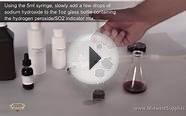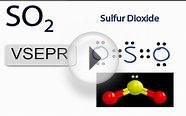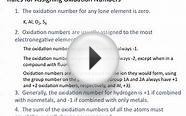
Oxidation number of sulfur in SO2
Before we will get to explanation very important disclaimer: oxidation numbers don't exist. They were invented to help in charge accounting needed when balancing redox reaction equations, but they don't refer to any real life chemical concept.
The general idea behind the oxidation numbers (ON) method for balancing chemical equations is that electrons are transferred between charged atoms. These charges - assigned to individual atoms - are called oxidation numbers, just to remind you that they don't reflect real structure of the reagents.
There are several simple rules used for assigning oxidation numbers to every atom present in any compound:
There are some exceptions to the rules 3 and 4 - for example oxygen in peroxides has oxidation number of -1, it is also not -2 in compounds with fluorine (where F is always -1), hydrogen in hydrides has oxidation number -1.
Before we will try to balance any equations let's use above rules to assign oxidation numbers to atoms in several substances.
For example - what is oxidation number of sulfur in SO2? Particle is not charged, so oxidation number of sulfur must equal sum of oxidation numbers of oxygens, but with the opposite sign. Oxygen oxidation number is -2, there are two oxygens - that gives -4 together, so sulfur must have ON=+4.
What is oxidation number of atoms in CrO42-? Oxygen is -2 and there are 4 oxygens - that gives overall of -8, ion has charge of -2, so central atom must have ON=+6.
How do we use oxidation numbers for balancing? First of all, we have to understand that oxidation means increase of oxidation number, while reduction means decrease of oxidation number. In both cases change of oxidation number is due to electrons lost (oxidation) or gained (reduction). We calculate oxidation numbers for all atoms present in the reaction equation (note that it is not that hard as it sounds, as for most atoms oxidation numbers will not change) and we look for a ratio that makes the number of electrons lost equal to the number of electrons gained. That gives us additional information needed for reaction balancing.
Let's try with following reaction:
KIO3 + KI + H2SO4 -> K2SO4 + H2O + I2
First of all - we don't need any spectators here, as they are only making things look more difficult then they are in reality. Quick glance tells us that the net ionic reaction is
You might also like




|
HumanoLabs Garcinia Cambogia Health and Beauty (HUMANOLABS™-Built to be Different)
|








